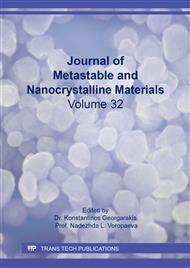[1]
M. Wang, Bioactive Materials and Processing, in: D. Shi (Ed.), Biomaterials and Tissue Engineering, Springer Berlin Heidelberg, Berlin, Heidelberg, 2004, pp.1-82.
Google Scholar
[2]
Y. Chen, X. Miao, Thermal and chemical stability of fluorohydroxyapatite ceramics with different fluorine contents, Biomaterials 26 (2005) 1205-1210.
DOI: 10.1016/j.biomaterials.2004.04.027
Google Scholar
[3]
M.F. Alif, W. Aprillia, S. Arief, Peat water purification by hydroxyapatite (hap) synthesized from waste pensi (corbicula moltkiana) shells, IOP Conference Series: Materials Science and Engineering 299 (2018) 012002.
DOI: 10.1088/1757-899x/299/1/012002
Google Scholar
[4]
L.J. Cummings, M.A. Snyder, K. Brisack, Chapter 24 Protein chromatography on hydroxyapatite columns, in: R.R. Burgess, M.P. Deutscher (Eds.), Methods in Enzymology, Academic Press, 2009, pp.387-404.
DOI: 10.1016/s0076-6879(09)63024-x
Google Scholar
[5]
E. Bernalte, J. Kamieniak, E.P. Randviir, Á. Bernalte-García, C.E. Banks, The preparation of hydroxyapatite from unrefined calcite residues and its application for lead removal from aqueous solutions, RSC Advances 9 (2019) 4054-4062.
DOI: 10.1039/c8ra04701d
Google Scholar
[6]
Y. Yang, Q. Wu, M. Wang, J. Long, Z. Mao, X. Chen, Hydrothermal synthesis of hydroxyapatite with different morphologies: influence of supersaturation of the reaction system, Cryst. Growth Des. 14 (2014) 4864-4871.
DOI: 10.1021/cg501063j
Google Scholar
[7]
L.-X. Yang, J.-J. Yin, L.-L. Wang, G.-X. Xing, P. Yin, Q.-W. Liu, Hydrothermal synthesis of hierarchical hydroxyapatite: Preparation, growth mechanism and drug release property, Ceram. Int. 38 (2012) 495-502.
DOI: 10.1016/j.ceramint.2011.07.033
Google Scholar
[8]
U. Boonyang, P. Chaopanich, A. Wongchaisuwat, P. Senthongkaew, S. Siripaisarnpipat, Effect of phosphate precursor on the production of hydroxyapatite from crocodile eggshells, J. Biomim. Biomater.Tissue Eng. 5 (2010) 31-37.
DOI: 10.4028/www.scientific.net/jbbte.5.31
Google Scholar
[9]
D.-M. Liu, T. Troczynski, W.J. Tseng, Water-based sol–gel synthesis of hydroxyapatite: process development, Biomaterials 22 (2001) 1721-1730.
DOI: 10.1016/s0142-9612(00)00332-x
Google Scholar
[10]
B.A.E. Ben-Arfa, I.M.M. Salvado, J.M.F. Ferreira, R.C. Pullar, Novel route for rapid sol-gel synthesis of hydroxyapatite, avoiding ageing and using fast drying with a 50-fold to 200-fold reduction in process time, Mater. Sci. Eng. C 70 (2017) 796-804.
DOI: 10.1016/j.msec.2016.09.054
Google Scholar
[11]
S. Türk, İ. Altınsoy, G. ÇelebiEfe, M. Ipek, M. Özacar, C. Bindal, Microwave–assisted biomimetic synthesis of hydroxyapatite using different sources of calcium, Mater. Sci. Eng. C 76 (2017) 528-535.
DOI: 10.1016/j.msec.2017.03.116
Google Scholar
[12]
A. Farzadi, M. Solati-Hashjin, F. Bakhshi, A. Aminian, Synthesis and characterization of hydroxyapatite/β-tricalcium phosphate nanocomposites using microwave irradiation, Ceram. Int. 37 (2011) 65-71.
DOI: 10.1016/j.ceramint.2010.08.021
Google Scholar
[13]
A. Yelten-Yilmaz, S. Yilmaz, Wet chemical precipitation synthesis of hydroxyapatite (HA) powders, Ceram. Int. 44 (2018) 9703-9710.
DOI: 10.1016/j.ceramint.2018.02.201
Google Scholar
[14]
I. Macha, U. Boonyang, S. Cazalbou, B. Ben-Nissan, C. Charvillat, F. N. Oktar, D. Grossin, Comparative study of Coral Conversion, Part 2: Microstructural evolution of calcium phosphate, J. Aust. Ceram. Soc. 51 (2015) 149-159.
Google Scholar
[15]
N. S. Al‐Qasas, S. Rohani, Synthesis of Pure Hydroxyapatite and the Effect of Synthesis Conditions on its Yield, Crystallinity, Morphology and Mean Particle Size, Sep. Sci. Technol. 40 (2005) 3187-3224.
DOI: 10.1080/01496390500385400
Google Scholar
[16]
W. Suchanek, M. Yoshimura, Processing and properties of hydroxyapatite-based biomaterials for use as hard tissue replacement implants, J. Mater. Res. 13 (1998) 94-117.
DOI: 10.1557/jmr.1998.0015
Google Scholar
[17]
R. F. J. Hu, J. J. Russell, B. Ben-Nissan, R. Vago, Australian coral as a biomaterial: Characteristics, J. Mater. Sci. Technol. 16 (2000) 591-595.
Google Scholar
[18]
N. A. I. Adnen, N. A. A. Halim, M. A. A. M. Nor, Development of hydroxyapatite from Setiu coral via hydrothermal method, AIP Conference Proceedings 1885 (2017) 020151.
DOI: 10.1063/1.5002345
Google Scholar
[19]
W. Liu, T. Wang, Y. Shen, H. Pan, S. Peng, W. W. Lu, Strontium incorporated coralline hydroxyapatite for engineering bone, ISRN Biomaterials 2013 (2013) 11.
DOI: 10.5402/2013/649163
Google Scholar
[20]
K. S. Vecchio, X. Zhang, J. B. Massie, M. Wang, C. W. Kim, Conversion of bulk seashells to biocompatible hydroxyapatite for bone implants, Acta Biomaterialia 3 (2007) 910-918.
DOI: 10.1016/j.actbio.2007.06.003
Google Scholar
[21]
S. Santhosh, S. B. Prabu, Characterization of nano-hydroxyapatite synthesized from seashells through wet chemical method, Int. J. Nanosci. 11 (2012) 1250031.
DOI: 10.1142/s0219581x12500317
Google Scholar
[22]
M. Z. A. Khiri, K. A. Matori, N. Zainuddin, C. A. C. Abdullah, Z. N. Alassan, N. F. Baharuddin, M. H. M. Zaid, The usability of ark clam shell (Anadara granosa) as calcium precursor to produce hydroxyapatite nanoparticle via wet chemical precipitate method in various sintering temperature, Springer Plus 5 (2016) 1206.
DOI: 10.1186/s40064-016-2824-y
Google Scholar
[23]
D. Reinares-Fisac, S. Veintemillas-Verdaguer, L. Fernández-Díaz, Conversion of biogenic aragonite into hydroxyapatite scaffolds in boiling solutions, Cryst. Eng. Comm. 19 (2017) 110-116.
DOI: 10.1039/c6ce01725h
Google Scholar
[24]
E. C. Moreno, M. Kresak, R. T. Zahradnik, Fluoridated Hydroxyapatite Solubility and Caries Formation, Nature 247 (1974) 64-65.
DOI: 10.1038/247064a0
Google Scholar
[25]
W. Xia, J. Lausmaa, P. Thomsen, H. Engqvist, Highly packed and aligned fluoride substituted hydroxyapatite via a surfactant-free process, J. Biomed. Mater. Res. B 100B (2012) 75-81.
DOI: 10.1002/jbm.b.31924
Google Scholar
[26]
C. J. Tredwin, A.M. Young, E.A. Abou Neel, G. Georgiou, J.C. Knowles, Hydroxyapatite, fluor-hydroxyapatite and fluorapatite produced via the sol–gel method: dissolution behaviour and biological properties after crystallisation, J. Mater. Sci-Mater. M. 25 (2014) 47-53.
DOI: 10.1007/s10856-013-5050-y
Google Scholar
[27]
B. Nasiri-Tabrizi, A. Fahami, Mechanochemical synthesis of fluorapatite-zinc oxide (FAp-ZnO) composite nanopowders, ISRN Ceram. 2012 (2012) 9.
DOI: 10.5402/2012/754704
Google Scholar
[28]
Y. Liu, W. Wang, Y. Zhan, C. Zheng, G. Wang, A simple route to hydroxyapatite nanofibers, Mater. Lett. 56 (2002) 496-501.
DOI: 10.1016/s0167-577x(02)00539-6
Google Scholar
[29]
M. Yoshimura, P. Sujaridworakun, F. Koh, T. Fujiwara, D. Pongkao, A. Ahniyaz, Hydrothermal conversion of calcite crystals to hydroxyapatite, Mater. Sci. Eng. C 24 (2004) 521-525.
DOI: 10.1016/j.msec.2004.01.005
Google Scholar
[30]
J. Shen, B. Jin, Q. Y. Jiang, Y. M. Hu, X. Y. Wang, Morphology-controlled synthesis of fluorapatite nano/microstructures via surfactant-assisted hydrothermal process, Mater. Design 97 (2016) 204-212.
DOI: 10.1016/j.matdes.2016.02.091
Google Scholar


